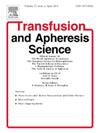Optimizing anti-seizure medication management in therapeutic plasma exchange: A practical case report
IF 1.2
4区 医学
Q4 HEMATOLOGY
引用次数: 0
Abstract
Therapeutic plasma exchange (TPE) is a widely employed procedure for treating several diseases. However, its impact on drug removal is understudied. In critical care settings, the therapeutic window is often narrow but crucial to optimize drug efficacy. This case report details a new onset of refractory status epilepticus, which required the administration of four concomitant anti-seizure medications and the implementation of TPE. We conducted drug monitoring before and after TPE sessions, describing for the first time the removal rate of midazolam and propofol during TPE (low removal rate), and confirming existing data concerning levetiracetam and phenytoin. In critically ill patients, the concomitant use of narrow therapeutic index drugs and plasma exchange requires close drug monitoring.
血浆置换治疗中抗癫痫药物管理的优化:一个实际病例报告
治疗性血浆置换(TPE)是一种广泛应用于治疗多种疾病的方法。然而,它对药物去除的影响尚未得到充分研究。在重症监护环境中,治疗窗口通常很窄,但对优化药物疗效至关重要。本病例报告详细介绍了难治性癫痫持续状态的新发作,需要同时服用四种抗癫痫药物和实施TPE。我们在TPE前后进行了药物监测,首次描述了TPE期间咪达唑仑和异丙酚的去除率(低去除率),并证实了已有的关于左乙拉西坦和苯妥英的数据。危重患者合用窄治疗指标药物和血浆置换需要严密的药物监测。
本文章由计算机程序翻译,如有差异,请以英文原文为准。
求助全文
约1分钟内获得全文
求助全文
来源期刊
CiteScore
3.60
自引率
5.30%
发文量
181
审稿时长
42 days
期刊介绍:
Transfusion and Apheresis Science brings comprehensive and up-to-date information to physicians and health care professionals involved in the rapidly changing fields of transfusion medicine, hemostasis and apheresis. The journal presents original articles relating to scientific and clinical studies in the areas of immunohematology, transfusion practice, bleeding and thrombotic disorders and both therapeutic and donor apheresis including hematopoietic stem cells. Topics covered include the collection and processing of blood, compatibility testing and guidelines for the use of blood products, as well as screening for and transmission of blood-borne diseases. All areas of apheresis - therapeutic and collection - are also addressed. We would like to specifically encourage allied health professionals in this area to submit manuscripts that relate to improved patient and donor care, technical aspects and educational issues.
Transfusion and Apheresis Science features a "Theme" section which includes, in each issue, a group of papers designed to review a specific topic of current importance in transfusion and hemostasis for the discussion of topical issues specific to apheresis and focuses on the operators'' viewpoint. Another section is "What''s Happening" which provides informal reporting of activities in the field. In addition, brief case reports and Letters to the Editor, as well as reviews of meetings and events of general interest, and a listing of recent patents make the journal a complete source of information for practitioners of transfusion, hemostasis and apheresis science. Immediate dissemination of important information is ensured by the commitment of Transfusion and Apheresis Science to rapid publication of both symposia and submitted papers.

 求助内容:
求助内容: 应助结果提醒方式:
应助结果提醒方式:


